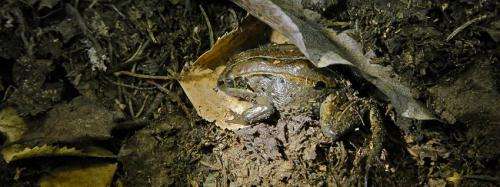Alaska frogs reach record lows in extreme temperature survival

Freezing and thawing might not be good for the average steak, but it seems to help wood frogs each fall as they prepare to survive Alaska's winter cold.
"Alaska wood frogs spend more time freezing and thawing outside than a steak does in your freezer and the frog comes back to life in the spring in better shape than the steak," said Don Larson, University of Alaska Fairbanks graduate student and lead author on a recent paper demonstrating that freeze tolerance in Alaska wood frogs is more extreme than previously thought.
Although wood frogs are well-studied freeze-tolerant amphibians, Larson's research is believed to be the first to examine the frogs under natural conditions.
In subarctic Interior Alaska, wood frogs overwinter in the ground covered by duff and leaf litter, creating a hibernacula, where temperatures can remain below freezing for more than six months with minimum temperatures of minus four (minus 20 Celsius).
Tracking wood frogs to their natural hibernacula, and using a fenced hibernacula in the Biological Reserve north of the UAF campus, Larson and co-author Brian Barnes, director of the UAF Institute of Arctic Biology and an expert in cold-climate physiology, wanted to know how cold and how long Alaska's wood frogs could survive in their natural habitat.
"Imagine what happens when you suck on a freeze pop," said Larson. "After you've sucked out all the sweet stuff, you're left with just ice. That's what happens to cells when they freeze. As ice formation pulls the water out of cells, the cells desiccate or dry out and eventually die."
Frogs prevent this freeze-pop effect by packing their cells with glucose (a kind of sugar) that reduces drying and stabilizes cells, a process scientists call cryoprotection.
"Concentrating sugar inside the cell helps balance the concentration of salts outside the cell that occurs as ice forms," said Barnes. "Less water leaves the cell than if sugar was not present and sugar and other cryoprotectants are thought to "hold" water inside the cell."
The curious thing Larson discovered is that when wood frogs are outside in their natural environment they accumulate much higher concentrations of glucose in their tissues than do frogs frozen in the lab.
Glucose concentrations in the outside frogs were 13-fold higher in muscle tissue, 10-fold higher in heart tissue and 3.3-fold higher in liver tissue compared to lab-frozen frogs, as described in their paper published in the Journal of Experimental Biology.
This extra protection enabled frogs to survive colder temperatures for a longer time than scientists previously thought, but Larson and Barnes wondered how they accumulated so much glucose?
Larson thinks the process that creates freezer burn on a frozen steak gives frogs the ability to survive being frozen at minimum temperatures below zero (minus 18 Celsius) for up to 218 days with 100 percent survival.
Frogs collected from sites in the Eastern U.S. and Canada have previously been shown to only survive being frozen for a few weeks and to no lower than about 19 degrees (minus 7.2 Celsius).
"In the field in early Autumn it's freezing during the night, thawing slightly during the day, and these repeated freezing episodes stimulate the frogs to release more and more glucose," Larson said. "It's not warm enough for long enough for the frog to reclaim much of that glucose and over time it accumulates giving the frog more protection against cell damage."
Discover the latest in science, tech, and space with over 100,000 subscribers who rely on Phys.org for daily insights. Sign up for our free newsletter and get updates on breakthroughs, innovations, and research that matter—daily or weekly.
Lab-frozen frogs are held at a constant temperature and without the freeze-thaw cycles Larson observed in the wild and so the frogs made glucose only when they initially froze and that was that.
"Whether the extremes in freezing tolerance in Alaska frogs as compared to more southern populations are due to patterns of temperature change during freezing or are due to genetic differences, and thereby represent evolutionary change, awaits further study," said Barnes.
The feats of freezing frogs are more than just a curiosity and may one day have application in the science of human organ transplantation.
"If science can figure out how to freeze human organs without damage it would allow more time to reach people in need of organs," said Larson.
Journal information: Journal of Experimental Biology
Provided by University of Alaska Fairbanks

















